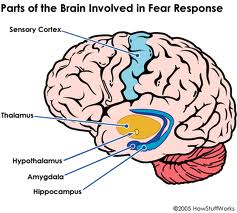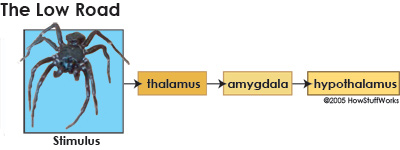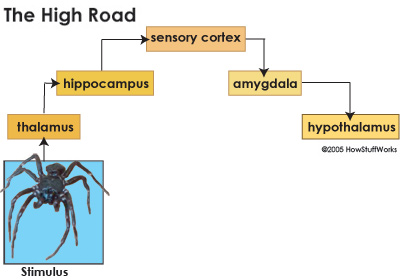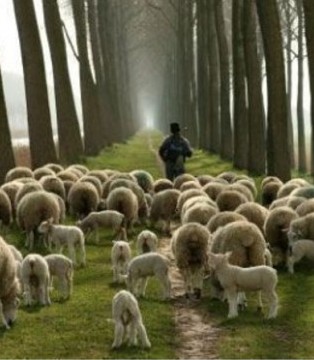The Right Road…

Yesterday, no the day before, I received some shocking news.
When bad news comes, we never expect it, don’t want it, and hope disparately that it isn’t true… a mistake, yes, yes, it has to be a mistake. Please let it be a mistake… But after the initial jolt, undoubtedly, my first reaction is FEAR. My heart starts pounding, I feel short of breath and find myself frozen in awkward poses and postures, caught as if a deer staring blankly like some solitary stone monument.
What is Fear?
According to Frank Herbert in his best seller, Dune, “fear is the mind-killer, the little-death that brings total obliteration” and of which I must face; permitting it to passage over me and through me. And when it has gone, I will turn the inner eye to see its path. Where the fear has gone there will be nothing……Only I will remain”. His mantra and intervention sounds rather lonely… isolated… I don’t want to be alone in my darkest hour and during greatest need.
 Physiologists at How Stuff Works, contend that fear is a chain reaction within the brain, called the fight-or-flight response. It begins with stressful stimuli and ends with the release of chemicals that cause the racing heart, fast breathing and tightened muscles. The stimulus could be a spider, an intruder in your home, an auditorium full of people waiting for you to speak or the sudden thud of your favorite book falling to the floor in the dark of night. Because cells in the brain are constantly transferring information and triggering responses, there are dozens of areas of the brain at least peripherally that are involved in fear. The thalamus decides where to send incoming sensory data from eyes, ears, mouth, skin. The Sensory cortex interprets sensory data. The Hippocampus stores and retrieves conscious memories; processes sets of stimuli to establish context. The Amygdala decodes emotions; determines possible threat; stores fear memories and the Hypothalamus activates “fight or flight” response.
Physiologists at How Stuff Works, contend that fear is a chain reaction within the brain, called the fight-or-flight response. It begins with stressful stimuli and ends with the release of chemicals that cause the racing heart, fast breathing and tightened muscles. The stimulus could be a spider, an intruder in your home, an auditorium full of people waiting for you to speak or the sudden thud of your favorite book falling to the floor in the dark of night. Because cells in the brain are constantly transferring information and triggering responses, there are dozens of areas of the brain at least peripherally that are involved in fear. The thalamus decides where to send incoming sensory data from eyes, ears, mouth, skin. The Sensory cortex interprets sensory data. The Hippocampus stores and retrieves conscious memories; processes sets of stimuli to establish context. The Amygdala decodes emotions; determines possible threat; stores fear memories and the Hypothalamus activates “fight or flight” response.
And as if this spontaneous and involuntary process, that we simply call fear, wasn’t hard enough to understand, it gets even more crazy complex. Creating fear takes place in the brain and is entirely unconscious. There are two paths involved in the fear response: The low road is quick and messy, while the high road takes more time and delivers a more precise interpretation of events. Both processes are happening simultaneously.
The idea behind the low road is “take no chances.” If the front door to your home is suddenly knocking against the frame, it could be the wind. It could also be a burglar trying to get in. It’s far less dangerous to assume its a burglar and have it turn out to be the wind than to assume it’s the wind and have it turn out to be a burglar. The low road shoots first and asks questions later. The process looks like this:  The door knocking against the door frame is the stimulus. As soon as you hear the sound and see the motion, your brain sends this sensory data to the thalamus. At this point, the thalamus doesn’t know if the signals it’s receiving are signs of danger or not, but since they might be, it forwards the information to the amygdala. The amygdala receives the neural impulses and takes action to protect you: It tells the hypothalamus to initiate the fight-or-flight response that could save your life if what you’re seeing and hearing turns out to be an intruder.
The door knocking against the door frame is the stimulus. As soon as you hear the sound and see the motion, your brain sends this sensory data to the thalamus. At this point, the thalamus doesn’t know if the signals it’s receiving are signs of danger or not, but since they might be, it forwards the information to the amygdala. The amygdala receives the neural impulses and takes action to protect you: It tells the hypothalamus to initiate the fight-or-flight response that could save your life if what you’re seeing and hearing turns out to be an intruder.
The high road is much more thoughtful. While the low road is initiating the fear response just in case, the high road is considering all of the options. Is it a burglar, or is it the wind? The long process looks like this:  When your eyes and ears sense the sound and motion of the door, they relay this information to the thalamus. The thalamus sends this information to the sensory cortex, where it is interpreted for meaning. The sensory cortex determines that there is more than one possible interpretation of the data and passes it along to the hippocampus to establish context. The hippocampus asks questions like, “Have I seen this particular stimulus before? If so, what did it mean that time? What other things are going on that might give me clues as to whether this is a burglar or a wind storm?” The hippocampus might pick up on other data being relayed through the high road, like the tapping of branches against a window, a muffled howling sound outside and the clatter of patio furniture flying about. Taking into account this other information, the hippocampus determines that the door action is most likely the result of wind. It sends a message to the amygdala that there is no danger, and the amygdala in turn tells the hypothalamus to shut off the fight-or-flight response.
When your eyes and ears sense the sound and motion of the door, they relay this information to the thalamus. The thalamus sends this information to the sensory cortex, where it is interpreted for meaning. The sensory cortex determines that there is more than one possible interpretation of the data and passes it along to the hippocampus to establish context. The hippocampus asks questions like, “Have I seen this particular stimulus before? If so, what did it mean that time? What other things are going on that might give me clues as to whether this is a burglar or a wind storm?” The hippocampus might pick up on other data being relayed through the high road, like the tapping of branches against a window, a muffled howling sound outside and the clatter of patio furniture flying about. Taking into account this other information, the hippocampus determines that the door action is most likely the result of wind. It sends a message to the amygdala that there is no danger, and the amygdala in turn tells the hypothalamus to shut off the fight-or-flight response.
Regardless of how one defines it, fear is not a pleasant sensation. Most of us would prefer not to experience it. Although it is also said that a small dose of fear is healthy and motivating, but again, I would not choose to experience it, if avoidance is possible. I don’t want to move or be motivated, especially if I am comfortable, sitting, standing, resting right where I am. That is, sitting on the promises, standing on the premises, resting in sufficiency. Praise be to God who sorts it all out for us.
I love Psalms 23.
1 The LORD is my shepherd; I shall not want.
2 He makes me lie down in green pastures. He leads me beside still waters.
3 He restores my soul. He leads me in paths of righteousness for his name’s sake.
4 Even though I walk through the valley of the shadow of death, I will fear no evil, for you are with me; your rod and your staff, they comfort me.
5 You prepare a table before me in the presence of my enemies; you anoint my head with oil; my cup overflows.
6 Surely goodness and mercy shall follow me all the days of my life, and I shall dwell in the house of the LORD forever.
 This wonderful Psalm melts my deepest fears into peaceful joy. The psalm isn’t about me at all, but about My Shepherd who cares for me when I am lost, alone and caught in the icy grip of agonizing, soul capturing fear. I especially love verse 4, for though I, as one of the sheep, should walk through the most dismal valley, in the dead of the night, exposed to pitfalls, precipices, devouring beasts, etc., I will fear no evil under the guidance and protection of such a Shepherd, My Shepherd. He knows all the passes, dangerous defiles, hidden pits, and abrupt precipices in the way; and he will guide me around, about, and through them. My God will lead and guide me in the path of righteousness, even though that path lies through the darkest and most gloomy night, through deep and dismal shades, in regions where there is no light, as if death had cast his dark and baleful shadow there… It is still the right path; it is a path of safety; and God will lead me to bright regions beyond. In that dark and gloomy valley of sadness, solitude, and sorrow, I will not fear; I will not be afraid of wandering or becoming lost in it; I will not be alarmed by enemies, for my Shepherd is there to guide me; He is greater still.
This wonderful Psalm melts my deepest fears into peaceful joy. The psalm isn’t about me at all, but about My Shepherd who cares for me when I am lost, alone and caught in the icy grip of agonizing, soul capturing fear. I especially love verse 4, for though I, as one of the sheep, should walk through the most dismal valley, in the dead of the night, exposed to pitfalls, precipices, devouring beasts, etc., I will fear no evil under the guidance and protection of such a Shepherd, My Shepherd. He knows all the passes, dangerous defiles, hidden pits, and abrupt precipices in the way; and he will guide me around, about, and through them. My God will lead and guide me in the path of righteousness, even though that path lies through the darkest and most gloomy night, through deep and dismal shades, in regions where there is no light, as if death had cast his dark and baleful shadow there… It is still the right path; it is a path of safety; and God will lead me to bright regions beyond. In that dark and gloomy valley of sadness, solitude, and sorrow, I will not fear; I will not be afraid of wandering or becoming lost in it; I will not be alarmed by enemies, for my Shepherd is there to guide me; He is greater still.
Please visit the link to Prayer Casts to better lift up our brothers and sisters in Christ.

 2. Praying through the Arabian Peninsula
2. Praying through the Arabian Peninsula 3. 24/7 Prayer
3. 24/7 Prayer One Way Ministries
One Way Ministries Prayercast
Prayercast